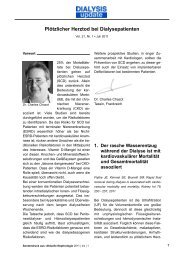Operations and Business Environment - Fresenius Medical Care
Operations and Business Environment - Fresenius Medical Care
Operations and Business Environment - Fresenius Medical Care
Create successful ePaper yourself
Turn your PDF publications into a flip-book with our unique Google optimized e-Paper software.
Clinical Databases<br />
Clinical databases such as EuCliD (European Clinical<br />
Database) are an important instrument for ensuring<br />
the quality of dialysis treatment. Firstly, we can record<br />
treatment data of dialysis patients, <strong>and</strong> secondly,<br />
EuCliD allows us to efficiently compare the treatment<br />
quality of individual dialysis clinics. Potential weak<br />
points can be more readily identified <strong>and</strong>, if necessary,<br />
counteractive measures can be applied instantly. EuCliD<br />
is therefore a significant component of our integrated<br />
quality management system <strong>and</strong> also assists nephrologists<br />
in providing comprehensive patient care.<br />
In 2006, more than 280 dialysis clinics added their information<br />
to this system. The database now contains<br />
information on about 24,000 dialysis patients. This<br />
represents about 85 % of our European dialysis clinics<br />
compared to about 80 % the year before. Furthermore,<br />
we implemented a new version of the EuCliD software<br />
for the documentation <strong>and</strong> analysis of treatment parameters,<br />
as well as improved monitoring of administration<br />
of dialysis drugs.<br />
This electronic system is expected to increase clinical<br />
<strong>and</strong> billing productivity, enhance clinical outcomes,<br />
reduce hospitalizations <strong>and</strong> make clinical workflows<br />
more adaptable to changes in regulatory requirements.<br />
From a data perspective, it improves our capability to<br />
analyze treatment quality <strong>and</strong> provides easier access<br />
to information for our caregivers <strong>and</strong> physicians.<br />
In the year under review, infrastructural aspects of the<br />
system such as networking (including wireless capabilities<br />
for qualifying clinics) have been phased in to over<br />
one thous<strong>and</strong> clinics. A touch-screen-based point-ofcare<br />
system has been successfully piloted <strong>and</strong> rolled<br />
out to over seventy clinics. Also owing to the acquisition<br />
of the Renal <strong>Care</strong> Group we successfully integrated<br />
these clinics into our information systems architecture.<br />
Following the integration of the additional RCG,<br />
the full system roll-out within the consolidated company<br />
is expected to be completed in 2009.<br />
87<br />
We are also in the process of introducing a significantly<br />
upgraded clinical <strong>and</strong> billing system in the U.S. This is a<br />
Web-enabled system that uses workflow technologies<br />
for process control <strong>and</strong> embedded analytics to provide<br />
advanced reporting capabilities. The system provides<br />
point-of-care capabilities to our physicians <strong>and</strong> clinical<br />
staff, reduces our dependency on paper<strong>and</strong> uses workflow<br />
technologies to monitor <strong>and</strong> instruct the execution<br />
of billing <strong>and</strong> clinical processes, escalating variances<br />
to supervisors.<br />
<strong>Fresenius</strong> <strong>Medical</strong> <strong>Care</strong> 2006








